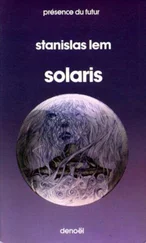The anthropomorphism and zoomorphism constantly present in the scientists’ desperate quests saw the ever newer productions of the living ocean as “sense organs” or even “limbs,” which for some time scholars such as Maartens or Ekkonai perceived in Giese’s vertebrids and rapidos. Yet these protuberances of the living ocean, sometimes soaring two miles into the atmosphere, are no more its limbs than an earthquake is gymnastic exercise for the earth’s crust.
The list of forms that occur relatively regularly, and are produced by the ocean sufficiently often that several dozen or even several hundred can be found on its surface in the course of an average day, runs to three hundred or so items. The most un-human, meaning those that bear absolutely no resemblance to anything experienced by humankind on Earth, are according to the Giese school the symmetriads. Even back then it was well established that the ocean did not behave aggressively, and one could perish in its plasmic depths only by truly striving to do so through one’s own imprudence or carelessness (naturally I don’t include accidents caused by malfunctioning equipment such as a damaged oxygen tank or cooling apparatus); and that even the cylindrical rivers of extensors and the monstrous pillars of vertebrids could be flown through in a airplane or other flying machine without the slightest danger. The plasma allowed free passage, parting before the foreign body at the equivalent of the speed of sound in the atmosphere of Solaris, and when forced to, even creating deep tunnels far beneath the surface of the ocean. (The energy it mobilized at such moments was massive — Skriabin calculated that in extreme cases it could amount to 10 9ergs!) Symmetriads were investigated with exceptional caution, constantly drawing back, adopting multiple safety measures (though, truth be told, these were often bogus); the names of those who first explored them are known to every child on Earth.
The direness of these giants doesn’t lie in their appearance, though that can truly induce nightmares. It rather arises from the fact that within them nothing is stable or certain; even the laws of physics are suspended. It was always those studying symmetriads who proclaimed most vociferously the thesis that the living ocean was rational.
Symmetriads arise without warning. Their beginning is a kind of eruption. About an hour beforehand, the ocean begins to gleam, as if it’s been covered with glass over an area of tens of square miles. Other than this, its fluidity and the rhythm of its waves remain unchanged. At times a symmetriad emerges where there is a funnel from an absorbed rapido, but this is not a rule. After an hour or so, the glassy coating rises upwards in a monstrous bubble that reflects the entire sky, sun and clouds and the whole horizon, shimmering and glinting. The lightning play of colors, caused partly by the curvature and partly by refraction of the light, has no parallel.
Particularly striking effects of light are produced by symmetriads that arise during the blue day and immediately before sunset. At such times it looks as if the planet is giving birth to another one, doubling its volume with every moment. The moment the globe with its flaming shimmer bursts from the depths, it splits at its highest point into vertical sectors, but it isn’t disintegrating. This stage, rather clumsily labeled the “calycate phase,” lasts only seconds. The arches of membranous spans rising into the sky become inverted, link up in the unseen interior and instantly begin to form something along the lines of a squat torso within which hundreds of things happen at once. In the very center, which was first studied by the seventy-person Hamalei expedition, a process of gigantocrystalization and polycrystalization leads to the emergence of an axial supporting pivot sometimes called a “spine,” though I am not a fan of the term. The precipitous architecture of this central pillar is held up in statu nascendi —as it is being born — by vertical columns of a jelly so diluted it’s almost watery, bursting endlessly from the mile-deep recesses. During this process the colossus emits a prolonged hollow roar, and is encircled by a shaft of snowy, coarse-celled foam that quakes furiously. There then follow, moving from the center to the periphery, extraordinarily complex revolutions of the hardened planes on which the layers of ductile matter rising from below have accumulated, while at the same time the deep-ocean geysers mentioned above condense and transform into mobile tentacle-like columns; clusters of them reach toward loci of construction that are strictly determined by the dynamics of the whole, recalling some sort of immense gills of an embryo growing a thousand times faster than normal, and streaming with pinkish blood and a green water so dark it’s almost black. From this moment the symmetriad begins to manifest its most extraordinary quality: the modeling or even suspension of laws of physics. Let us begin by saying that no two symmetriads are alike and that the geometry of each is, as it were, an “invention” of the living ocean. So then, the symmetriad produces in its interior things that are often called “instant machines,” though these formations bear no resemblance to machines constructed by people — the term only refers to a certain “mechanical” purposiveness of operation.
When the geysers erupting far beneath the ocean surface solidify or swell into thick-walled galleries and corridors that run in every direction, and the “membranes” form a system of intersecting planes, overhangs, and ceilings, the symmetriad justifies its name by the fact that each intricate arrangement of passages, pathways, and inclines within one of its poles has a faithful copy at the other.
After twenty or thirty minutes the giant slowly begins to sink, occasionally first leaning between eight and twelve degrees in the vertical axis. There are larger and smaller symmetriads, but even the dwarves rise a good two and a half thousand feet over the horizon after they begin to submerge, and can be seen from miles away. It’s safest to enter their interior immediately after they reach stability, since the whole ceases to drop into the ocean, and at the same time it returns to the perfectly perpendicular. The best point of entry is the area just below the summit. In this place the relatively smooth polar “cap” is encircled by an area honeycombed with funnel-shaped openings to inner chambers and channels. This configuration constitutes, as a whole, a three-dimensional solution to a higher-order equation.
It’s common knowledge that any equation can be expressed in the figural language of higher geometry, and a solid can be constructed that is its equivalent. In this understanding, a symmetriad is a relative of Lobachevsky’s cones and Riemann’s negative curvatures, but a very distant relative, due to its unimaginable complexity. Occupying an area of several cubic miles, it constitutes the solution to an entire mathematical system; this solution, furthermore, is four-dimensional, since certain essential coefficients in the equation are also expressed in time, that is to say, in the changes brought about by its passing.
Naturally, the simplest conception was that this was no more and no less than a “mathematical machine” of the living ocean, a model created on its own scale for calculations it needed for some unknown purpose; but this idea, the Fermont Hypothesis, is no longer credited. It was tempting, to be sure; but the claim that these titanic eruptions, every tiny particle of which was constantly subject to the complicating formulas of the overall analysis, were being used by the living ocean to examine questions of matter, space, existence — this notion proved untenable. Too many phenomena were to be found in the giant’s innards that could not be reconciled with such a simple (some said childishly naive) depiction.
Читать дальше












